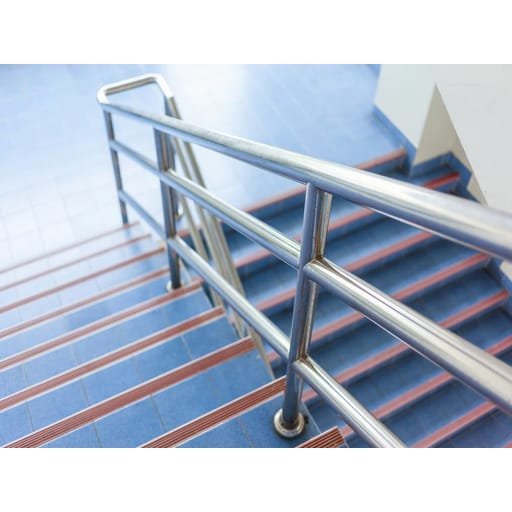In the heart of the UAE’s architectural boom, from Dubai’s high-rise skylines to Abu Dhabi’s state-of-the-art public spaces, safety and aesthetics continue to evolve side by side. While massive investments are poured into glass façades, imported flooring, and automation systems, one often-overlooked yet essential element plays a vital role in shaping a safe and stylish environment: the handrail. Particularly in commercial settings—malls, office towers, airports, and hospitals—stainless steel handrails have become indispensable for their functionality, elegance, and enduring quality.
Modern commercial design in the UAE demands materials that can keep up with both visual expectations and environmental challenges. One of the strongest choices available today is Stainless Steel Handrails for stairs. These railings offer superior performance in the face of intense use, extreme weather conditions, and the design standards of world-class architecture. As commercial projects grow in scale and ambition, developers, architects, and safety inspectors are increasingly turning to stainless steel as a go-to solution that delivers on all fronts—compliance, safety, style, and sustainability.
The Functional Role of Handrails in Commercial Settings
Handrails may seem simple, but they are integral to the safety and flow of movement within any commercial space. In stairways, ramps, atriums, and even emergency exits, handrails help guide users, prevent falls, and offer accessibility for people with disabilities or mobility challenges. In the UAE, strict building codes issued by the Dubai Municipality and other regulatory authorities mandate the use of sturdy, compliant railings in all public and commercial structures.
Aesthetically, handrails contribute to the flow of interior and exterior design. In modern commercial architecture, especially in places like the DIFC or Abu Dhabi Global Market, they are designed not only to serve but to enhance. Stainless steel stands out in this aspect—polished or brushed, it complements everything from glass balustrades to marble staircases without clashing or fading.
Why Stainless Steel is the Ideal Material
The UAE’s environment presents unique challenges. The high humidity, salt-laden air from the coast, and scorching summer heat demand materials that can endure without rusting, cracking, or fading. Stainless steel, particularly grades 304 and 316, excels in this context. It offers unparalleled corrosion resistance, making it suitable for both interior and exterior applications in places like Jumeirah, Jebel Ali, or the Abu Dhabi Corniche.
Moreover, stainless steel handrails require minimal maintenance. Unlike wood, which may warp or fade, or painted metals, which require regular touch-ups, stainless steel simply needs periodic cleaning with water or a mild detergent. This low-maintenance aspect is crucial for commercial properties where daily operations cannot afford frequent disruptions for repairs or replacements.
Versatility in Design and Application
From a design perspective, stainless steel offers extraordinary flexibility. Whether the project requires curved rails, modular systems, or integration with other materials like tempered glass or natural stone, stainless steel can be fabricated to meet precise architectural needs. It can be laser-cut, CNC-bent, or welded into intricate patterns, allowing for high levels of customization.
Designers and developers working on commercial projects in Dubai Marina, Business Bay, or Al Reem Island often prefer stainless steel for its ability to fit into both modern minimalist and high-luxury environments. It adapts well to trending styles—sleek, matte-finished staircases or reflective high-polish handrails in luxury hotel lobbies.
Safety, Compliance, and Accessibility Standards
In commercial projects, safety is not optional—it is a legal and operational necessity. The UAE’s building codes are based on international standards and mandate that handrails meet strict criteria in terms of height, spacing, load-bearing capacity, and surface finish. Stainless steel handrails are engineered to comply with these standards.
Handrails in areas with high foot traffic, such as metro stations or malls like The Dubai Mall, must withstand not just weight but impact and daily wear. Stainless steel’s inherent strength and durability make it an ideal choice in such high-pressure environments. For fire safety, its non-combustible nature and performance under high temperatures provide an added layer of protection.
Applications Across UAE’s Commercial Landscape
Across the UAE’s rapidly expanding commercial infrastructure, stainless steel handrails are visible in a variety of environments:
- Corporate Buildings: Executive towers in Downtown Dubai or Al Maryah Island use stainless steel handrails for staircases and balconies, often paired with clear glass for a modern, transparent look.
- Shopping Malls: From City Centre Deira to Yas Mall, commercial centers choose stainless steel for its easy maintenance, long life, and sleek design.
- Hotels and Hospitality: Luxury resorts and boutique hotels integrate stainless steel handrails to achieve a premium feel in staircases, pools, and spa areas.
- Healthcare Facilities: Hospitals and clinics in areas like Al Barsha or Khalifa City need hygienic, durable, and safe railing solutions, which stainless steel effortlessly provides.
- Educational Institutions: Universities and schools prioritize safe, code-compliant railings in stairways, and stainless steel offers a strong yet visually light solution.
Fabrication and Installation: Why Local Expertise Matters
In commercial projects, lead times, compliance, and execution must be seamless. Working with UAE-based metal fabricators ensures the handrails are custom-made to fit exact measurements, adhere to local building codes, and can be installed quickly. Local specialists like Beyond–Steel utilize CNC bending machines, MIG and TIG welding, and laser cutting to achieve high precision.
These manufacturers can offer additional features such as anti-microbial coatings for healthcare environments, integrated LED strips for retail or hospitality staircases, or special finishes for branding consistency. Importantly, their deep understanding of UAE regulations and environment ensures quality outcomes without delays.
Long-Term Value and Sustainability
One of stainless steel’s most underrated benefits is its sustainability. It’s 100% recyclable, which helps support the UAE’s growing emphasis on green building standards, such as Estidama in Abu Dhabi and LEED compliance in Dubai. Stainless steel handrails do not degrade easily, so they reduce the frequency of material replacement and the associated labor and waste.
For commercial developers, this translates to significant long-term savings. While the initial cost may be higher than some alternatives, the durability, minimal maintenance, and resistance to environmental damage make stainless steel the smarter investment over time.
Final Thoughts: The Ideal Commercial Fit
In a region where safety, aesthetics, and climate resistance converge, stainless steel emerges as the ideal material for stair handrails in commercial developments. From its exceptional strength and longevity to its sleek appearance and low environmental impact, stainless steel handrails offer a complete package.
As UAE cities continue to grow and innovate, the demand for reliable and stylish building components will only increase. By investing in Stainless Steel Handrails for stairs, property developers, architects, and facility managers ensure they are aligning with the highest standards of design, safety, and performance. Whether it’s a new corporate tower or a revitalized retail space, stainless steel delivers results that last—and look good doing it.







